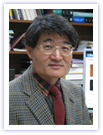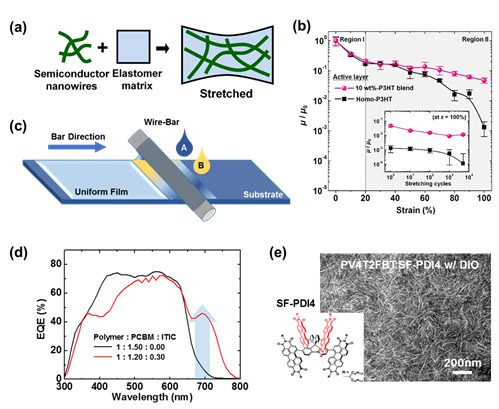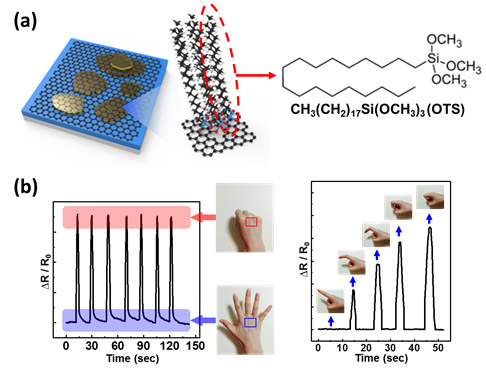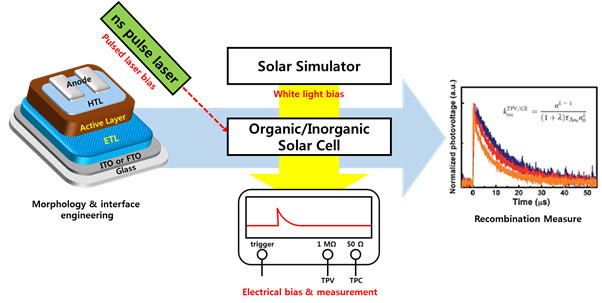2-1. Nano-Structure and Interface Engineering of Soft Molecular Materials for Soft Electronics
| Participants
member
 |
member_detail
| Name : | Kilwon Cho |
| Affiliation : | POSTECH |
| Tel : | +82-54-279-2270 |
| E-mail : | kwcho@postech.ac.kr |
| Homepage : | http://crg.postech.ac.kr |
|
|
member
 |
member_detail
| Name : | Boseok Kang |
| Affiliation : | SKKU Advanced Institute of Nano Technology, Sungkyunkwan University |
| Tel : | +82-31-299-4175 |
| E-mail : | bskang88@skku.edu |
| Homepage : | http://nano.skku.edu/main.php |
|
|
| Research Purpose
Investigation on the correlation between molecular structure and property of nanomaterials by manipulating structure and interface of molecular soft nanomaterials, and development of fundamental technologies for flexible, stretchable soft nanomaterials via optimization of molecular structure and property in order to develop soft electronics
| Contents
Topic 1. Development of hybridization of multi-component soft materials for high carrier mobility and mechanical stability
- Fabrication of high performance and flexible OTFTs using cross-linking of reactive high-k liquid robber
- Fabrication of large area, soft OTFT array using blend-based bar coating
- Fabrication of high performance OPVs using ternary photoactive layer for broad absorption
- Synthesis of non-fullerene acceptors for high performance OPVs

(a) Schematic diagram showing the stretchable organic semiconducting materials by elastomeric blending (b) The strain dependence of OFET performances based on the blend or non-blend systems. (c) wire-bar coating process for the large area and uniform thin films. (d) Enhancing photovoltaic performance of organic solar cells through complementary light absorption in ternary blend. (e) Molecular structure of SF-PDI4 non-fullerene acceptor and TEM image of optimized PV4T2FBT:SF-PDI4 blend films for organic solar cells
Topic 2. Molecular design and microstructure control for flexible soft semiconductors
- Fabrication of high performance and stretchable OTFTs using block-copolymers with stretchable blocks
- Development of soft thermoelectric device and wearable healthcare monitoring system with chevron structure and porous insulator

Novel stretchable polymer semiconductors incorporating elastomer building block
Topic 3. Development of interface control of soft materials using functionalized nanotemplate
- Development of high performance and stretchable OTFTs via surface-modified dielectric materials and molecular self assembly
- Development of direct growth of poly cyclic aromatic hydrocabon–based graphene on dielectric materials
- Development of transparent and stretchable electrode with self assembly monolayer-modified graphene for e-skin
- Fabrication of soft OTFTs using flexible electrode with interface control and work function tuning
- Fabrication of high performance thermoelectric device via polymer self assembly on CNT nanotemplate

Surface-Mediated Molecular Assembly

(a) Self assembly monolayer-modified graphene. (b) SAM-modified graphene based strain sensor
Topic 4. Development of interface control and analysis for enhancement of driving stability of flexible materials and electronics
- Development of highly stable copper wire electrode using graphene passivation layer - Development of charge selective materials for high performance organic/inorganic hybrid photovoltaics - Fabrication of highly stable organic/inorganic hybrid photovoltaics by controlling crystallization mechanism of photoactive materials - Study on molecular structure- and interface control-dependent charge carrier trapping mechanism using PECCS - Study on molecular orientation at donor/acceptor interface in photoactive layer using FTPS - Study on crystal growth mechanism of organic/inorganic hybrid perovskite using TrPL - Study on exciton and its life in soft materials using TrPL up-conversion

| Expected Contribution
- Providing fundamental technologies to demonstrate human friendly soft electronics from investigation of molecular structure and interface
- Developing soft nanomaterial-based high performance and flexible, stretchable electronics through molecular design, nanomaterial blend and interface control
- Providing design strategies for soft nanomateirals through detailed analysis of physical, optical, electrical properties of soft nanomaterials
- Driving soft electronic applications and related high value-added industry
| Representative Research Achievement
1. H. H. Kim, Y. Chung, E. Lee, S. K. Lee, K. Cho, Adv. Mater. 2014, 26, 3213.
2. J. H. Oh, M. P. Hong, B. S. Kim, Y. U. Lee, US 7,638,358 (12-29-2009)
3. N. N. Nguyen, S. B. Jo, S. K. Lee, D. H. Sin, B. Kang, H. H. Kim, H. Lee, and K. Cho, Nano Lett. 2015, 15, 2474
4. B. Kang, M. Jang, Y. Chung, H. Kim, S. K. Kwak, J. H. Oh, K. Cho, Nat. Commun. 2014, 5, 4752
 HOME >연구내용 >핵심과제1
HOME >연구내용 >핵심과제1




